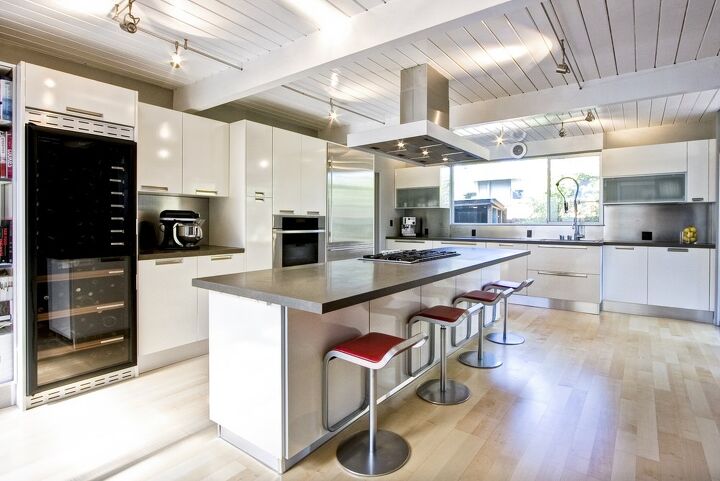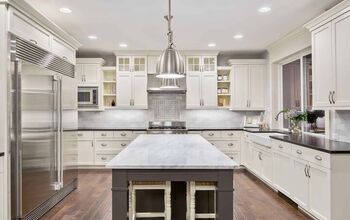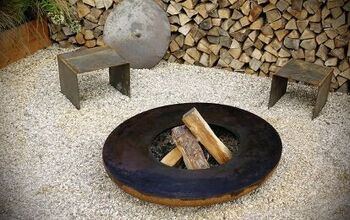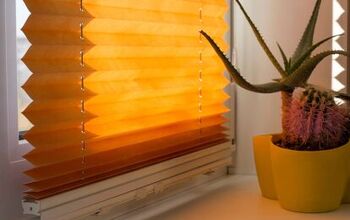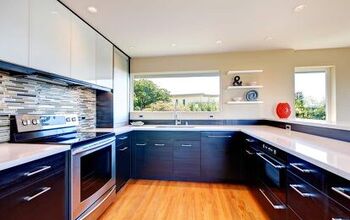What Are The Pros And Cons Of Lacquer Kitchen Cabinets? (Find Out Now!)

Everything old is new again. Once popular in the 1970s, lacquer kitchen cabinets are back in style to offer your space a modern vibe. Lacquer is an easy DIY solution to update your cabinets and breathe some new life into your kitchen.
Protecting wood from the inside out, lacquer is a quick-drying solution that can be applied and dried in a single day. Lacquer can be clear or colored and comes in different sheens. While not difficult to clean, it’s otherwise high maintenance and prone to staining, cracks, dents, and visible imperfections. Lacquer lasts for about 10 years.
Do You Need to Hire Cabinet Installers?
Get free, zero-commitment quotes from pro contractors near you.

What is Lacquer?
Lacquer is a solvent-based product that creates a hard, smooth protective coating on your cabinets when it dries. This coating is achieved by painting several layers of lacquer over wood cabinets to give an opaque, even finish.
Lacquer can be painted or sprayed and comes in a variety of colors and sheens.
Lacquer vs. Varnish
You may think that because lacquer is a wood-finishing technique it’s the same as varnish. However, this is not true. Firstly, varnish is only available in a clear finish, but lacquer can be clear or colored.
Not only that, but lacquer is thinner, so it dries more quickly than varnish. A lacquered surface is much more protective than one that’s been varnished.
Pros of Lacquer Kitchen Cabinets
Applying lacquer to your kitchen cabinets has many benefits. Lacquer protects your cabinets from a variety of damages while being relatively easy to clean. Because it comes in many different varieties, you can customize your style. Its reasonable prices and ease of use make it a great choice for a DIY project.
Durable and Long-Lasting
Lacquer’s durable properties make it breathable and waterproof. It’s highly resistant to damages from acid, alkali, water, and abrasions. The seal protects the wood from the inside out, and you can preserve the look even longer by applying a few occasional coats.
Lacquer lasts for up to 10 years, much longer than comparable finishes. It won’t flake like varnish, shellac, natural stains, or polyurethane. These finishes tend to yellow over time, but lacquer stays clear longer.
Varying Aesthetics
There are so many options when choosing lacquer. Between the colors and sheens, you can customize your cabinets exactly to your liking.
Lacquer gives a smooth, level finish to your cabinets and is available in every color you can imagine. Apply clear lacquer to natural, unstained wood for a more rustic look. Or apply a rich stain and a glossy lacquer for a luxurious, high-end look. You can even tint the lacquer in varying degrees so that it produces everything from a color-wash effect to a solid paint-like coating.
There are even different sheens available. Lacquer comes in matte, medium, or high-gloss finishes, each bringing its own aesthetic. A matte finish gives a modern edge while a high-gloss finish adds some luxury and a medium finish lands somewhere in between.
White Lacquer
The most popular color for lacquer is white, and because of this, it’s readily available in stores. White naturally reflects light, making a space feel bigger. When you combine white lacquer with a high-gloss finish, it transforms your kitchen into an ultra-modern space that looks so much bigger than its footprint.
Not only is white lacquer a great choice for a small space, but it makes it harder to detect fingerprints on your cabinets!
Quick and Easy Application
You don’t need much skill to use lacquer. It’s a great method for DIYers to give a quick upgrade to your kitchen cabinets. You can apply lacquer either via a paintbrush or sprayer.
For kitchen cabinets, especially those with a flat façade, spraying is the easiest and smoothest application. When you spray lacquer, it melts into the cabinets, rather than sticking to the surface. The benefit of this is a smoother finish. Spraying won’t leave brush strokes or bubbles.
In addition to the quick application of a sprayer, lacquer dries very quickly. At room temperature, it can dry in 15 minutes. This makes it possible to apply several coats in one day and potentially complete the project. Its quick drying time means you can also use the cabinets immediately.
Easy to Clean
As long as you clean lacquer cabinets with a soft cloth and non-abrasive detergents, they’ll stay looking new. For tougher stains, a solution of lightly diluted ethyl alcohol is acceptable.
Reasonably Priced
For a professional to come in and refinish your cabinets with lacquer, it can cost between $4 and $10 per square foot. This is comparable to professionally refinishing with paint as well. Obviously, this number goes down drastically if you do it yourself.
When determining how much lacquer you need, it will depend on how many cabinets you have and how many coats you apply. Check with your local hardware store for your specific needs. Below is a price comparison of different lacquer brands to get an idea of how much it would cost you to do it yourself.
| Brand | Store | Price (per gallon) |
| Deft Clear Wood Finish Brushing Lacquer (Semi-Gloss) | Ace Hardware | $38.99 |
| Mohawk Finisher’s Choice Lacquer | Pro Cabinet Supply | $39.64 |
| Lenmar UltraLaq White Precatalyzed Lacquer | Benjamin Moore Spectrum Paint Center | $49.99 |
Cons of Lacquer Kitchen Cabinets
While all these things are well and good, the kitchen may not be the best place for lacquer cabinets. Out of all rooms in the house, the kitchen sees the most foot traffic. Kitchen cabinets tend to be used and abused, and lacquer has a difficult time competing with all that plus the humid environment.
Durable to a Point
Yes, lacquer is durable. However, there is much dispute about whether it’s more durable than its counterparts. It won’t yellow with age, which is great, but its durability falters in other ways.
Lacquer is prone to staining, cracks, dents, and visible imperfections, all of which can easily be caused by the daily wear and tear seen in a kitchen. Speaking of cracking, lacquer is very brittle. Wood’s natural response to expand and contract in changing temperatures causes lacquer to crack.
Lacquer can be horribly scratched or discolored if you use the following: acetone, thinner, trichloroethylene, ammonia, abrasive creams, and steel wool pads.
High Maintenance
Because of the toll a kitchen cabinet takes, a lacquered one needs to be refinished more often. The lifespan of a lacquer cabinet is roughly 10 years, but it’s likely they’ll need to be refinished before then. It’s possible to preserve the look for longer if you apply a coat every few years.
If you go with a high-gloss finish, you’ll need special furniture polish that’s formulated for lacquer to keep them clean. Glossy lacquer tends to show dirt, fingerprints, and scratches even more so than other finishes.
Lacquer and Humidity
Lacquer doesn’t like humidity. It doesn’t stand up well to saltwater, heat, or steam. I’m pretty sure that all of these things can be found in a kitchen on a regular basis…
If you have lacquer kitchen cabinets, you’ll notice they first start to break down around the sink and stove, which are areas of high humidity levels. If your coffeemaker sits on the counter under a cabinet, the lacquer will quickly break down there, too.
BlushingBlushing is a phenomenon that happens to a lacquered surface for a variety of reasons. Usually, it occurs when the lacquer is applied in a humid environment. If you spray lacquer in high humidity, it will immediately produce a milky-white blotch across the surface.
Blushing can be avoided if you apply lacquer in a more even-tempered environment. Should blushing occur, you can rub the lacquer off with steel wool and start again. It usually clears on its own by the following day.
Related Questions
Which is better for cabinets: paint or lacquer?
Lacquer is less high maintenance than paint and would be the better choice between the two. It’s easier to clean, more resistant to chemicals and dries much faster.After a while, paint loses its shine from being cleaned too much. To prevent this, you can apply a clear coat after you paint, but lacquer doesn’t require that extra step.
Does lacquer have a strong smell?
Lacquer produces very strong fumes during use. In some people, the smell can bring on a headache. If applying lacquer indoors, the space should be properly ventilated to help dissipate the smell. Ideally, it’s best to apply lacquer outdoors if you can.
How many coats of lacquer should you do?
Generally, three coats are enough, although you can technically do as many as you want. To ensure a good bond, you should scuff between each coat. However, you should not scuff the final coat.
Do You Need to Hire Cabinet Installers?
Get free, zero-commitment quotes from pro contractors near you.

Conclusion
Available in a variety of colors and sheens, lacquer kitchen cabinets bring a sleek, modern vibe to your kitchen. Lacquer is an easy-to-use and reasonably priced product that bodes well for DIY projects. It also dries so quickly that you can lacquer your cabinets in a single day.
While it provides a durable coating, lacquer has a tendency to crack, stain, and blush. It requires a good bit of maintenance and reapplication to keep it looking new.

Brigid Levi is a wife, mother, and freelance writer who enjoys a good DIY project and creating beautiful spaces within her home. From cleaning and organization hacks to home decor ideas, she loves helping people in their quest to turn a house into a home. Her hobbies include pretending to be Joanna Gaines while updating her home with her husband and performing in local theater productions.
More by Brigid Levi



